Group Report: Impact of IT on Healthcare - BIT205, Ethics
VerifiedAdded on 2022/11/16
|7
|2573
|445
Report
AI Summary
This report, prepared as a group assignment for the 'The IT Professional' unit (BIT205), examines the multifaceted impact of technology on the healthcare industry. The report addresses key areas such as technological innovations, data privacy and security, and potential issues arising from IT implementation in healthcare settings. Through case studies focusing on specific healthcare scenarios, the report provides detailed analyses of the challenges and benefits associated with integrating technology into medical practices. Issues like technology glitches, privacy breaches, and misuse of technology are discussed, along with recommendations for mitigation and best practices. The report emphasizes the importance of data governance, real-time security analytics, and privacy-preserving techniques to ensure patient data protection. The findings highlight the need for informed decision-making, patient consent, and adherence to ethical guidelines to maximize the benefits of technological advancements while minimizing potential risks. The report concludes with a strong emphasis on the need for continuous evaluation and adaptation to maintain data security and patient privacy in an evolving technological landscape.
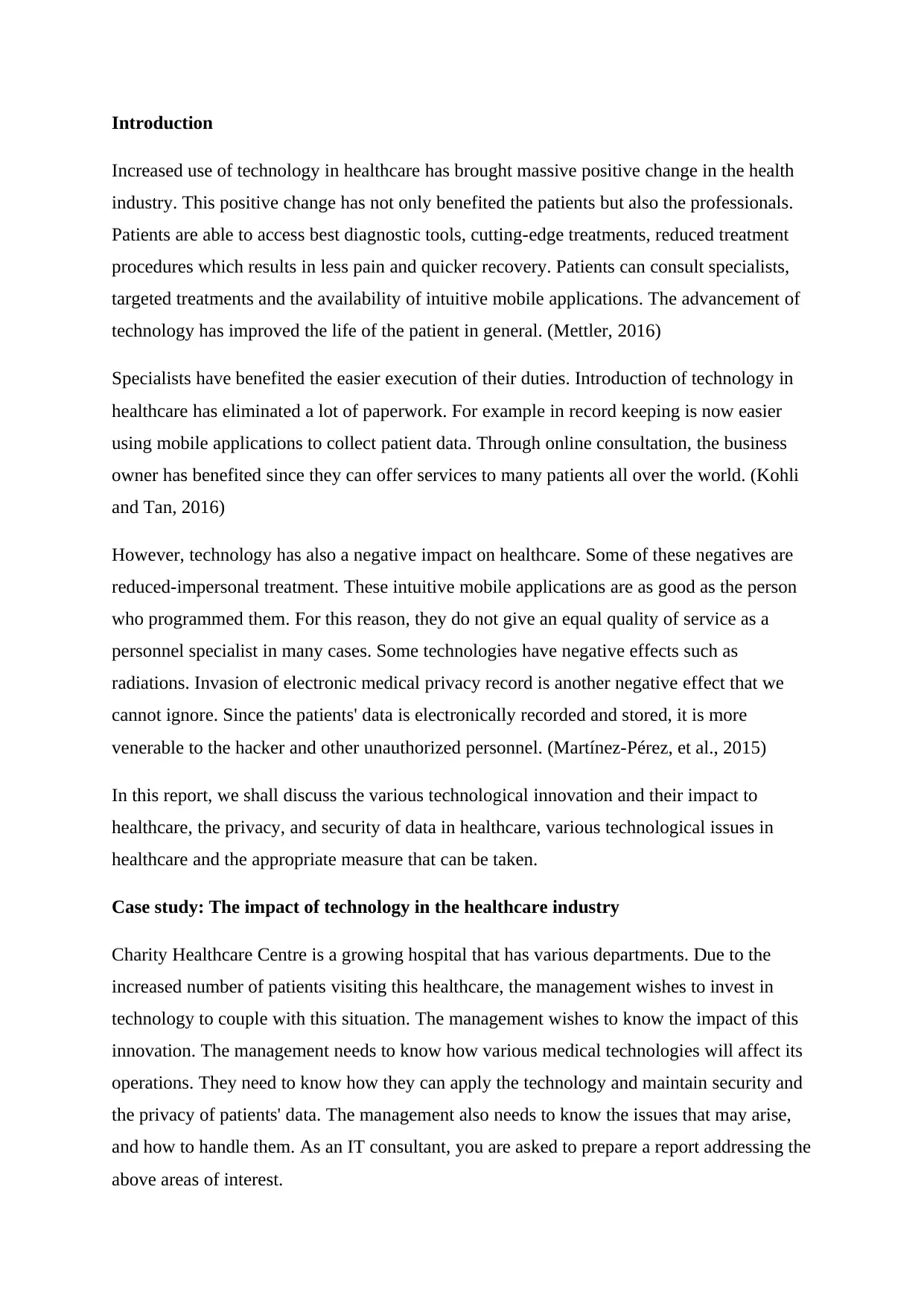
Introduction
Increased use of technology in healthcare has brought massive positive change in the health
industry. This positive change has not only benefited the patients but also the professionals.
Patients are able to access best diagnostic tools, cutting-edge treatments, reduced treatment
procedures which results in less pain and quicker recovery. Patients can consult specialists,
targeted treatments and the availability of intuitive mobile applications. The advancement of
technology has improved the life of the patient in general. (Mettler, 2016)
Specialists have benefited the easier execution of their duties. Introduction of technology in
healthcare has eliminated a lot of paperwork. For example in record keeping is now easier
using mobile applications to collect patient data. Through online consultation, the business
owner has benefited since they can offer services to many patients all over the world. (Kohli
and Tan, 2016)
However, technology has also a negative impact on healthcare. Some of these negatives are
reduced-impersonal treatment. These intuitive mobile applications are as good as the person
who programmed them. For this reason, they do not give an equal quality of service as a
personnel specialist in many cases. Some technologies have negative effects such as
radiations. Invasion of electronic medical privacy record is another negative effect that we
cannot ignore. Since the patients' data is electronically recorded and stored, it is more
venerable to the hacker and other unauthorized personnel. (Martínez-Pérez, et al., 2015)
In this report, we shall discuss the various technological innovation and their impact to
healthcare, the privacy, and security of data in healthcare, various technological issues in
healthcare and the appropriate measure that can be taken.
Case study: The impact of technology in the healthcare industry
Charity Healthcare Centre is a growing hospital that has various departments. Due to the
increased number of patients visiting this healthcare, the management wishes to invest in
technology to couple with this situation. The management wishes to know the impact of this
innovation. The management needs to know how various medical technologies will affect its
operations. They need to know how they can apply the technology and maintain security and
the privacy of patients' data. The management also needs to know the issues that may arise,
and how to handle them. As an IT consultant, you are asked to prepare a report addressing the
above areas of interest.
Increased use of technology in healthcare has brought massive positive change in the health
industry. This positive change has not only benefited the patients but also the professionals.
Patients are able to access best diagnostic tools, cutting-edge treatments, reduced treatment
procedures which results in less pain and quicker recovery. Patients can consult specialists,
targeted treatments and the availability of intuitive mobile applications. The advancement of
technology has improved the life of the patient in general. (Mettler, 2016)
Specialists have benefited the easier execution of their duties. Introduction of technology in
healthcare has eliminated a lot of paperwork. For example in record keeping is now easier
using mobile applications to collect patient data. Through online consultation, the business
owner has benefited since they can offer services to many patients all over the world. (Kohli
and Tan, 2016)
However, technology has also a negative impact on healthcare. Some of these negatives are
reduced-impersonal treatment. These intuitive mobile applications are as good as the person
who programmed them. For this reason, they do not give an equal quality of service as a
personnel specialist in many cases. Some technologies have negative effects such as
radiations. Invasion of electronic medical privacy record is another negative effect that we
cannot ignore. Since the patients' data is electronically recorded and stored, it is more
venerable to the hacker and other unauthorized personnel. (Martínez-Pérez, et al., 2015)
In this report, we shall discuss the various technological innovation and their impact to
healthcare, the privacy, and security of data in healthcare, various technological issues in
healthcare and the appropriate measure that can be taken.
Case study: The impact of technology in the healthcare industry
Charity Healthcare Centre is a growing hospital that has various departments. Due to the
increased number of patients visiting this healthcare, the management wishes to invest in
technology to couple with this situation. The management wishes to know the impact of this
innovation. The management needs to know how various medical technologies will affect its
operations. They need to know how they can apply the technology and maintain security and
the privacy of patients' data. The management also needs to know the issues that may arise,
and how to handle them. As an IT consultant, you are asked to prepare a report addressing the
above areas of interest.
Paraphrase This Document
Need a fresh take? Get an instant paraphrase of this document with our AI Paraphraser
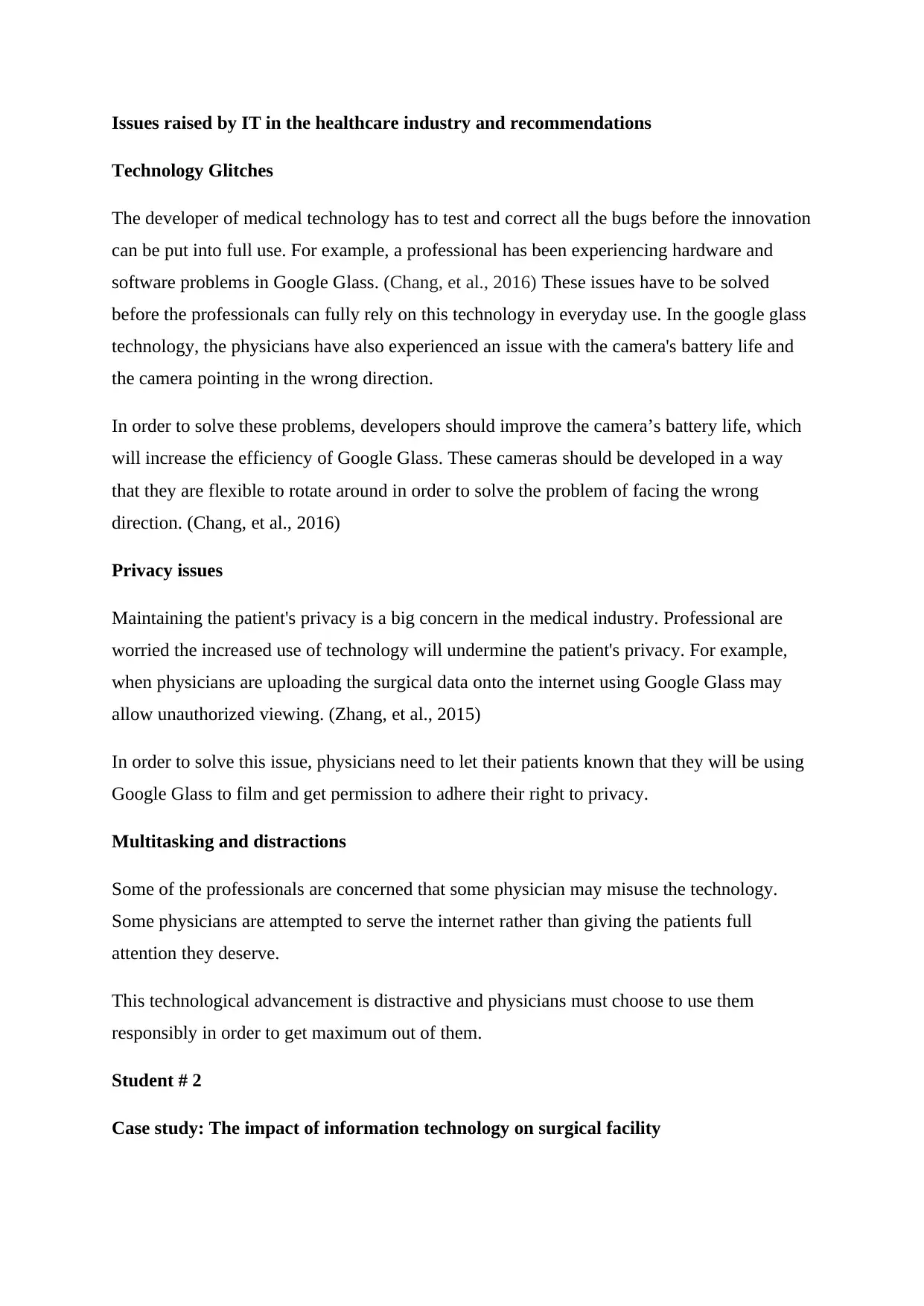
Issues raised by IT in the healthcare industry and recommendations
Technology Glitches
The developer of medical technology has to test and correct all the bugs before the innovation
can be put into full use. For example, a professional has been experiencing hardware and
software problems in Google Glass. (Chang, et al., 2016) These issues have to be solved
before the professionals can fully rely on this technology in everyday use. In the google glass
technology, the physicians have also experienced an issue with the camera's battery life and
the camera pointing in the wrong direction.
In order to solve these problems, developers should improve the camera’s battery life, which
will increase the efficiency of Google Glass. These cameras should be developed in a way
that they are flexible to rotate around in order to solve the problem of facing the wrong
direction. (Chang, et al., 2016)
Privacy issues
Maintaining the patient's privacy is a big concern in the medical industry. Professional are
worried the increased use of technology will undermine the patient's privacy. For example,
when physicians are uploading the surgical data onto the internet using Google Glass may
allow unauthorized viewing. (Zhang, et al., 2015)
In order to solve this issue, physicians need to let their patients known that they will be using
Google Glass to film and get permission to adhere their right to privacy.
Multitasking and distractions
Some of the professionals are concerned that some physician may misuse the technology.
Some physicians are attempted to serve the internet rather than giving the patients full
attention they deserve.
This technological advancement is distractive and physicians must choose to use them
responsibly in order to get maximum out of them.
Student # 2
Case study: The impact of information technology on surgical facility
Technology Glitches
The developer of medical technology has to test and correct all the bugs before the innovation
can be put into full use. For example, a professional has been experiencing hardware and
software problems in Google Glass. (Chang, et al., 2016) These issues have to be solved
before the professionals can fully rely on this technology in everyday use. In the google glass
technology, the physicians have also experienced an issue with the camera's battery life and
the camera pointing in the wrong direction.
In order to solve these problems, developers should improve the camera’s battery life, which
will increase the efficiency of Google Glass. These cameras should be developed in a way
that they are flexible to rotate around in order to solve the problem of facing the wrong
direction. (Chang, et al., 2016)
Privacy issues
Maintaining the patient's privacy is a big concern in the medical industry. Professional are
worried the increased use of technology will undermine the patient's privacy. For example,
when physicians are uploading the surgical data onto the internet using Google Glass may
allow unauthorized viewing. (Zhang, et al., 2015)
In order to solve this issue, physicians need to let their patients known that they will be using
Google Glass to film and get permission to adhere their right to privacy.
Multitasking and distractions
Some of the professionals are concerned that some physician may misuse the technology.
Some physicians are attempted to serve the internet rather than giving the patients full
attention they deserve.
This technological advancement is distractive and physicians must choose to use them
responsibly in order to get maximum out of them.
Student # 2
Case study: The impact of information technology on surgical facility
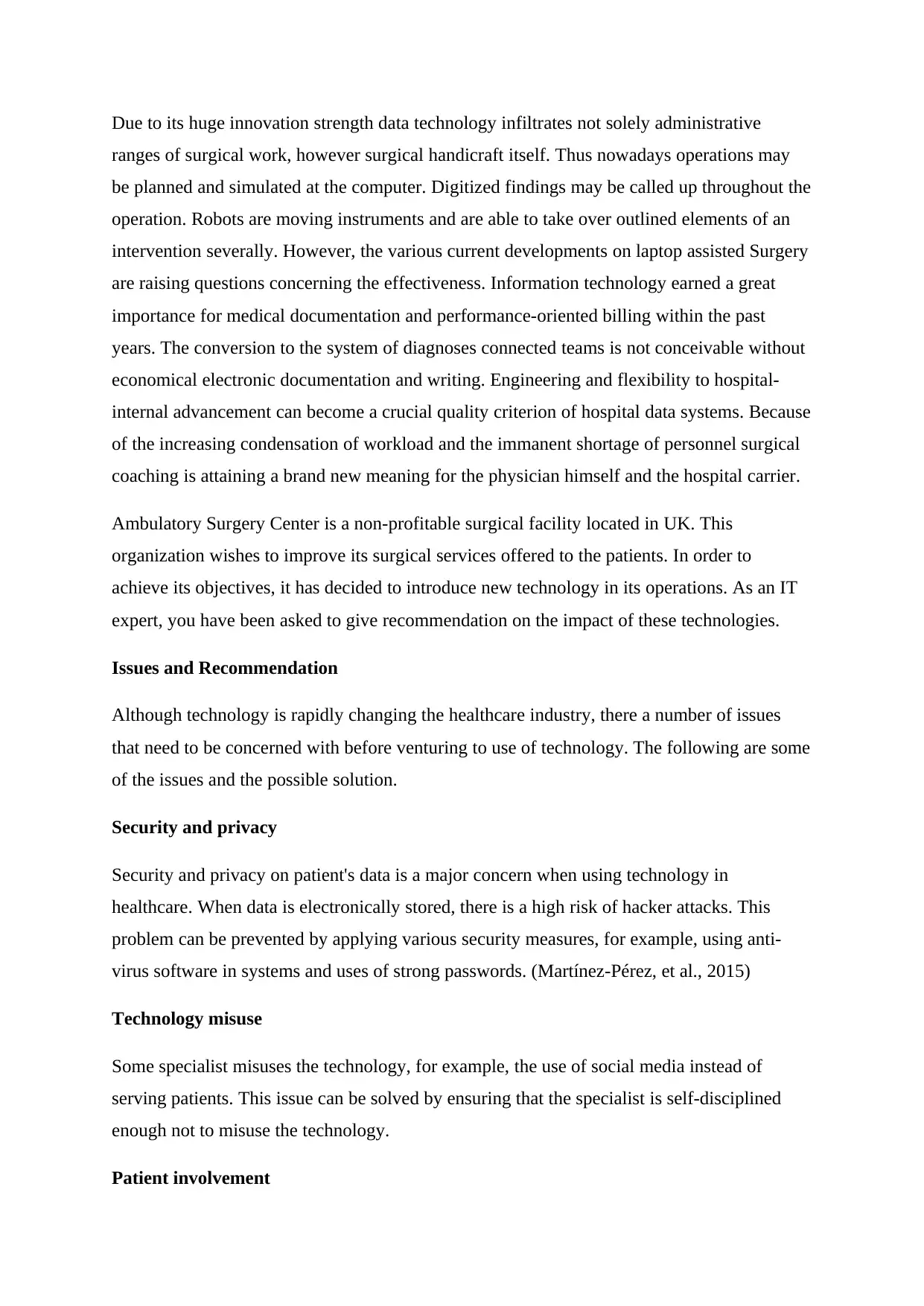
Due to its huge innovation strength data technology infiltrates not solely administrative
ranges of surgical work, however surgical handicraft itself. Thus nowadays operations may
be planned and simulated at the computer. Digitized findings may be called up throughout the
operation. Robots are moving instruments and are able to take over outlined elements of an
intervention severally. However, the various current developments on laptop assisted Surgery
are raising questions concerning the effectiveness. Information technology earned a great
importance for medical documentation and performance-oriented billing within the past
years. The conversion to the system of diagnoses connected teams is not conceivable without
economical electronic documentation and writing. Engineering and flexibility to hospital-
internal advancement can become a crucial quality criterion of hospital data systems. Because
of the increasing condensation of workload and the immanent shortage of personnel surgical
coaching is attaining a brand new meaning for the physician himself and the hospital carrier.
Ambulatory Surgery Center is a non-profitable surgical facility located in UK. This
organization wishes to improve its surgical services offered to the patients. In order to
achieve its objectives, it has decided to introduce new technology in its operations. As an IT
expert, you have been asked to give recommendation on the impact of these technologies.
Issues and Recommendation
Although technology is rapidly changing the healthcare industry, there a number of issues
that need to be concerned with before venturing to use of technology. The following are some
of the issues and the possible solution.
Security and privacy
Security and privacy on patient's data is a major concern when using technology in
healthcare. When data is electronically stored, there is a high risk of hacker attacks. This
problem can be prevented by applying various security measures, for example, using anti-
virus software in systems and uses of strong passwords. (Martínez-Pérez, et al., 2015)
Technology misuse
Some specialist misuses the technology, for example, the use of social media instead of
serving patients. This issue can be solved by ensuring that the specialist is self-disciplined
enough not to misuse the technology.
Patient involvement
ranges of surgical work, however surgical handicraft itself. Thus nowadays operations may
be planned and simulated at the computer. Digitized findings may be called up throughout the
operation. Robots are moving instruments and are able to take over outlined elements of an
intervention severally. However, the various current developments on laptop assisted Surgery
are raising questions concerning the effectiveness. Information technology earned a great
importance for medical documentation and performance-oriented billing within the past
years. The conversion to the system of diagnoses connected teams is not conceivable without
economical electronic documentation and writing. Engineering and flexibility to hospital-
internal advancement can become a crucial quality criterion of hospital data systems. Because
of the increasing condensation of workload and the immanent shortage of personnel surgical
coaching is attaining a brand new meaning for the physician himself and the hospital carrier.
Ambulatory Surgery Center is a non-profitable surgical facility located in UK. This
organization wishes to improve its surgical services offered to the patients. In order to
achieve its objectives, it has decided to introduce new technology in its operations. As an IT
expert, you have been asked to give recommendation on the impact of these technologies.
Issues and Recommendation
Although technology is rapidly changing the healthcare industry, there a number of issues
that need to be concerned with before venturing to use of technology. The following are some
of the issues and the possible solution.
Security and privacy
Security and privacy on patient's data is a major concern when using technology in
healthcare. When data is electronically stored, there is a high risk of hacker attacks. This
problem can be prevented by applying various security measures, for example, using anti-
virus software in systems and uses of strong passwords. (Martínez-Pérez, et al., 2015)
Technology misuse
Some specialist misuses the technology, for example, the use of social media instead of
serving patients. This issue can be solved by ensuring that the specialist is self-disciplined
enough not to misuse the technology.
Patient involvement
⊘ This is a preview!⊘
Do you want full access?
Subscribe today to unlock all pages.

Trusted by 1+ million students worldwide
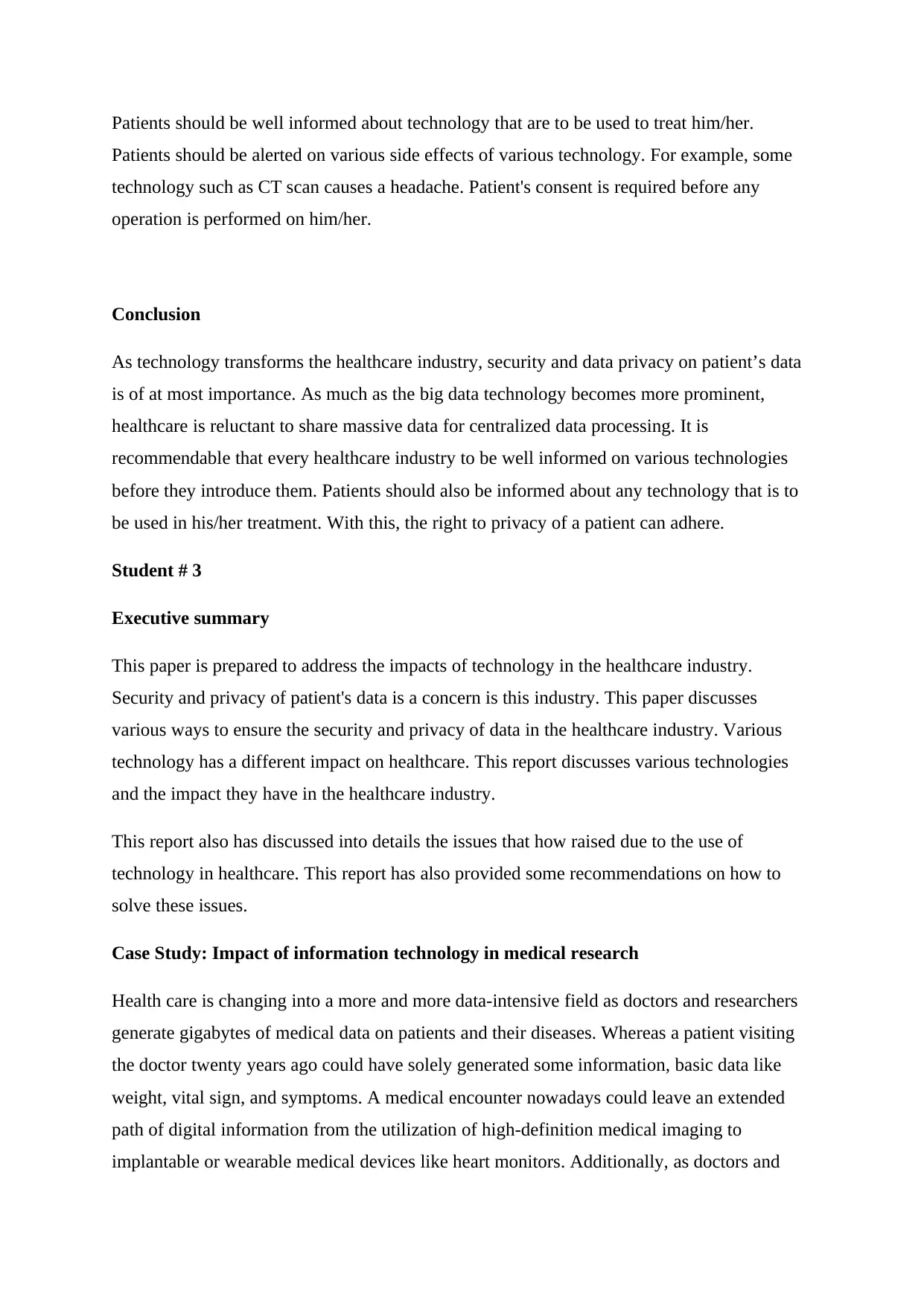
Patients should be well informed about technology that are to be used to treat him/her.
Patients should be alerted on various side effects of various technology. For example, some
technology such as CT scan causes a headache. Patient's consent is required before any
operation is performed on him/her.
Conclusion
As technology transforms the healthcare industry, security and data privacy on patient’s data
is of at most importance. As much as the big data technology becomes more prominent,
healthcare is reluctant to share massive data for centralized data processing. It is
recommendable that every healthcare industry to be well informed on various technologies
before they introduce them. Patients should also be informed about any technology that is to
be used in his/her treatment. With this, the right to privacy of a patient can adhere.
Student # 3
Executive summary
This paper is prepared to address the impacts of technology in the healthcare industry.
Security and privacy of patient's data is a concern is this industry. This paper discusses
various ways to ensure the security and privacy of data in the healthcare industry. Various
technology has a different impact on healthcare. This report discusses various technologies
and the impact they have in the healthcare industry.
This report also has discussed into details the issues that how raised due to the use of
technology in healthcare. This report has also provided some recommendations on how to
solve these issues.
Case Study: Impact of information technology in medical research
Health care is changing into a more and more data-intensive field as doctors and researchers
generate gigabytes of medical data on patients and their diseases. Whereas a patient visiting
the doctor twenty years ago could have solely generated some information, basic data like
weight, vital sign, and symptoms. A medical encounter nowadays could leave an extended
path of digital information from the utilization of high-definition medical imaging to
implantable or wearable medical devices like heart monitors. Additionally, as doctors and
Patients should be alerted on various side effects of various technology. For example, some
technology such as CT scan causes a headache. Patient's consent is required before any
operation is performed on him/her.
Conclusion
As technology transforms the healthcare industry, security and data privacy on patient’s data
is of at most importance. As much as the big data technology becomes more prominent,
healthcare is reluctant to share massive data for centralized data processing. It is
recommendable that every healthcare industry to be well informed on various technologies
before they introduce them. Patients should also be informed about any technology that is to
be used in his/her treatment. With this, the right to privacy of a patient can adhere.
Student # 3
Executive summary
This paper is prepared to address the impacts of technology in the healthcare industry.
Security and privacy of patient's data is a concern is this industry. This paper discusses
various ways to ensure the security and privacy of data in the healthcare industry. Various
technology has a different impact on healthcare. This report discusses various technologies
and the impact they have in the healthcare industry.
This report also has discussed into details the issues that how raised due to the use of
technology in healthcare. This report has also provided some recommendations on how to
solve these issues.
Case Study: Impact of information technology in medical research
Health care is changing into a more and more data-intensive field as doctors and researchers
generate gigabytes of medical data on patients and their diseases. Whereas a patient visiting
the doctor twenty years ago could have solely generated some information, basic data like
weight, vital sign, and symptoms. A medical encounter nowadays could leave an extended
path of digital information from the utilization of high-definition medical imaging to
implantable or wearable medical devices like heart monitors. Additionally, as doctors and
Paraphrase This Document
Need a fresh take? Get an instant paraphrase of this document with our AI Paraphraser
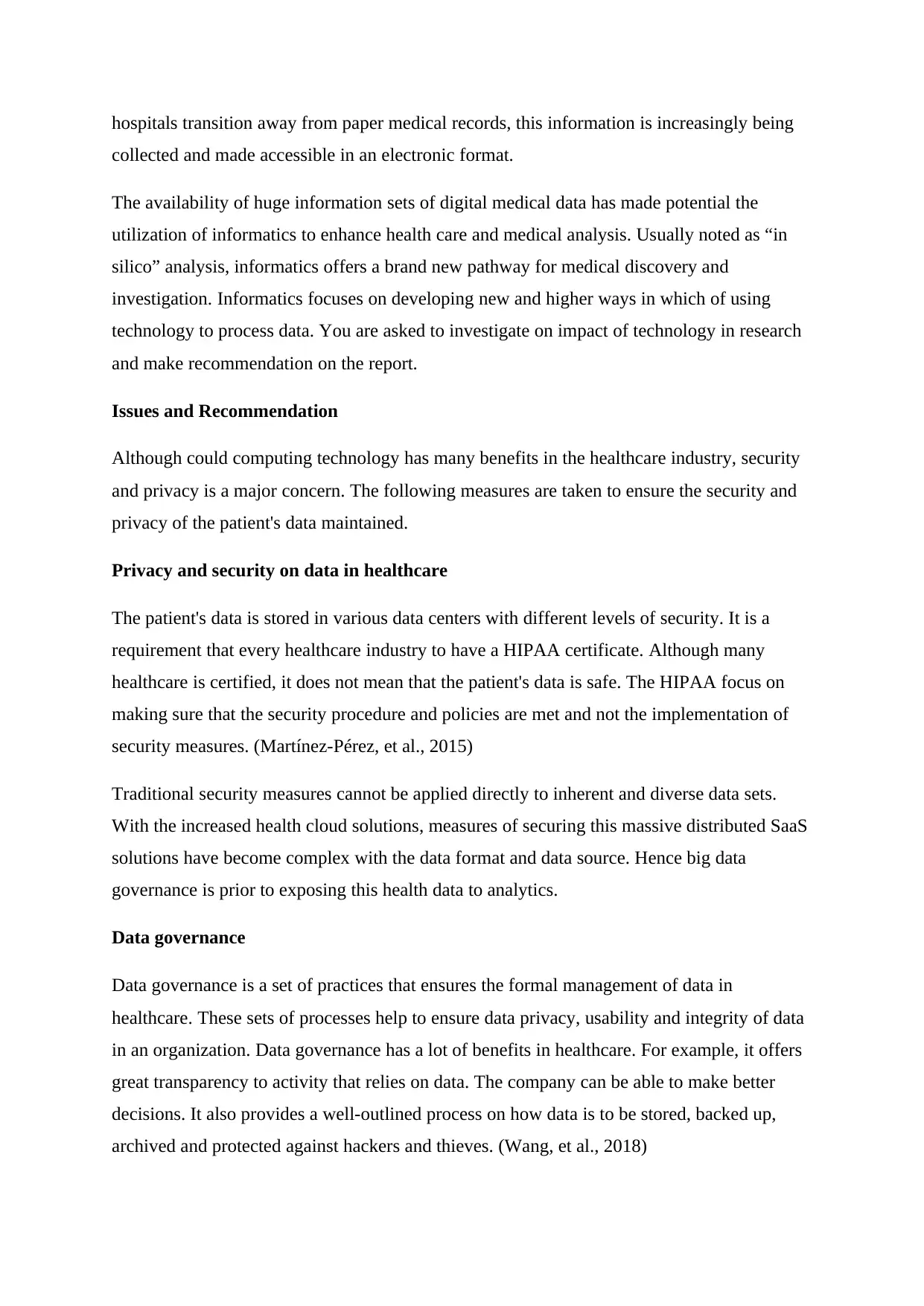
hospitals transition away from paper medical records, this information is increasingly being
collected and made accessible in an electronic format.
The availability of huge information sets of digital medical data has made potential the
utilization of informatics to enhance health care and medical analysis. Usually noted as “in
silico” analysis, informatics offers a brand new pathway for medical discovery and
investigation. Informatics focuses on developing new and higher ways in which of using
technology to process data. You are asked to investigate on impact of technology in research
and make recommendation on the report.
Issues and Recommendation
Although could computing technology has many benefits in the healthcare industry, security
and privacy is a major concern. The following measures are taken to ensure the security and
privacy of the patient's data maintained.
Privacy and security on data in healthcare
The patient's data is stored in various data centers with different levels of security. It is a
requirement that every healthcare industry to have a HIPAA certificate. Although many
healthcare is certified, it does not mean that the patient's data is safe. The HIPAA focus on
making sure that the security procedure and policies are met and not the implementation of
security measures. (Martínez-Pérez, et al., 2015)
Traditional security measures cannot be applied directly to inherent and diverse data sets.
With the increased health cloud solutions, measures of securing this massive distributed SaaS
solutions have become complex with the data format and data source. Hence big data
governance is prior to exposing this health data to analytics.
Data governance
Data governance is a set of practices that ensures the formal management of data in
healthcare. These sets of processes help to ensure data privacy, usability and integrity of data
in an organization. Data governance has a lot of benefits in healthcare. For example, it offers
great transparency to activity that relies on data. The company can be able to make better
decisions. It also provides a well-outlined process on how data is to be stored, backed up,
archived and protected against hackers and thieves. (Wang, et al., 2018)
collected and made accessible in an electronic format.
The availability of huge information sets of digital medical data has made potential the
utilization of informatics to enhance health care and medical analysis. Usually noted as “in
silico” analysis, informatics offers a brand new pathway for medical discovery and
investigation. Informatics focuses on developing new and higher ways in which of using
technology to process data. You are asked to investigate on impact of technology in research
and make recommendation on the report.
Issues and Recommendation
Although could computing technology has many benefits in the healthcare industry, security
and privacy is a major concern. The following measures are taken to ensure the security and
privacy of the patient's data maintained.
Privacy and security on data in healthcare
The patient's data is stored in various data centers with different levels of security. It is a
requirement that every healthcare industry to have a HIPAA certificate. Although many
healthcare is certified, it does not mean that the patient's data is safe. The HIPAA focus on
making sure that the security procedure and policies are met and not the implementation of
security measures. (Martínez-Pérez, et al., 2015)
Traditional security measures cannot be applied directly to inherent and diverse data sets.
With the increased health cloud solutions, measures of securing this massive distributed SaaS
solutions have become complex with the data format and data source. Hence big data
governance is prior to exposing this health data to analytics.
Data governance
Data governance is a set of practices that ensures the formal management of data in
healthcare. These sets of processes help to ensure data privacy, usability and integrity of data
in an organization. Data governance has a lot of benefits in healthcare. For example, it offers
great transparency to activity that relies on data. The company can be able to make better
decisions. It also provides a well-outlined process on how data is to be stored, backed up,
archived and protected against hackers and thieves. (Wang, et al., 2018)
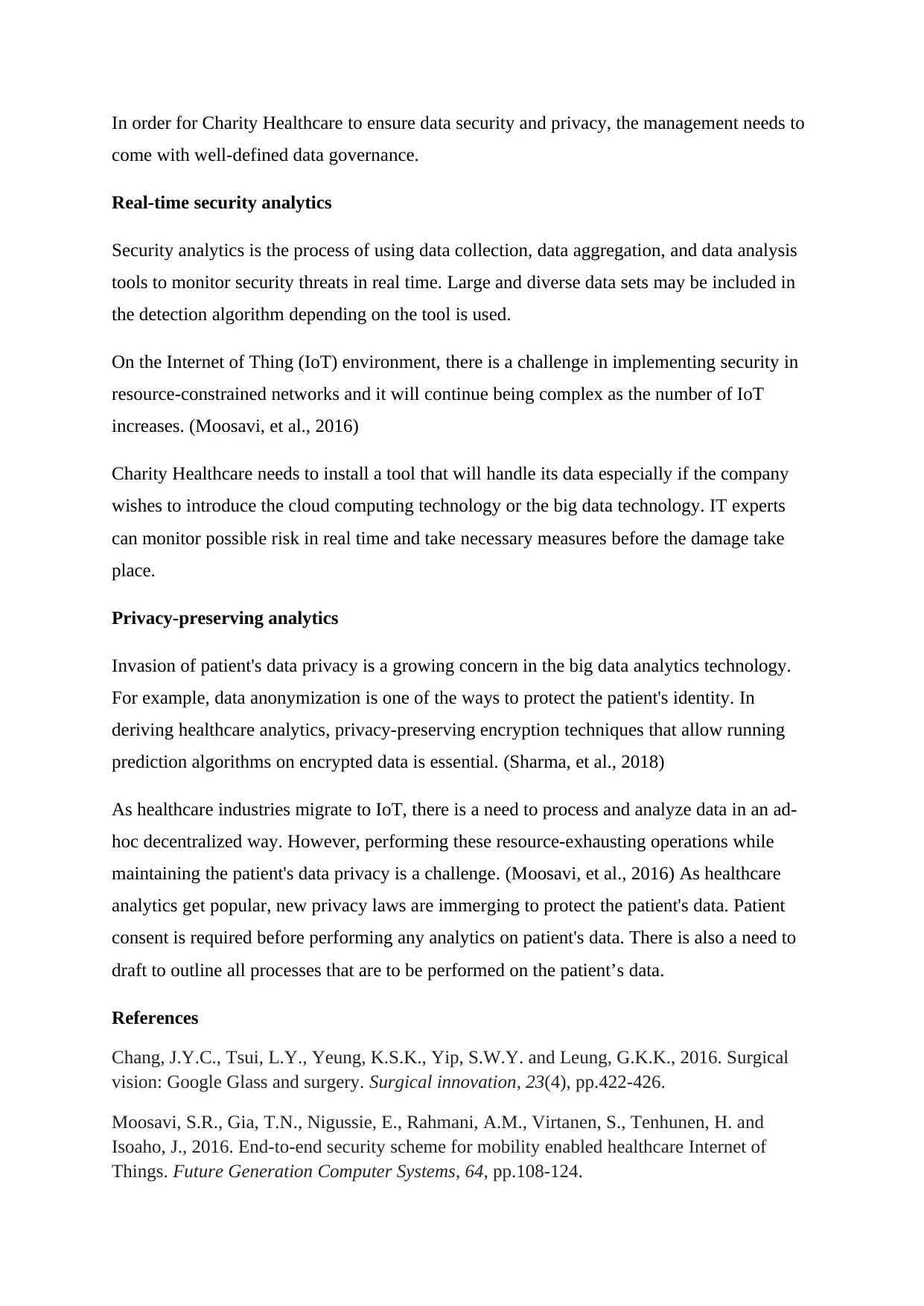
In order for Charity Healthcare to ensure data security and privacy, the management needs to
come with well-defined data governance.
Real-time security analytics
Security analytics is the process of using data collection, data aggregation, and data analysis
tools to monitor security threats in real time. Large and diverse data sets may be included in
the detection algorithm depending on the tool is used.
On the Internet of Thing (IoT) environment, there is a challenge in implementing security in
resource-constrained networks and it will continue being complex as the number of IoT
increases. (Moosavi, et al., 2016)
Charity Healthcare needs to install a tool that will handle its data especially if the company
wishes to introduce the cloud computing technology or the big data technology. IT experts
can monitor possible risk in real time and take necessary measures before the damage take
place.
Privacy-preserving analytics
Invasion of patient's data privacy is a growing concern in the big data analytics technology.
For example, data anonymization is one of the ways to protect the patient's identity. In
deriving healthcare analytics, privacy-preserving encryption techniques that allow running
prediction algorithms on encrypted data is essential. (Sharma, et al., 2018)
As healthcare industries migrate to IoT, there is a need to process and analyze data in an ad-
hoc decentralized way. However, performing these resource-exhausting operations while
maintaining the patient's data privacy is a challenge. (Moosavi, et al., 2016) As healthcare
analytics get popular, new privacy laws are immerging to protect the patient's data. Patient
consent is required before performing any analytics on patient's data. There is also a need to
draft to outline all processes that are to be performed on the patient’s data.
References
Chang, J.Y.C., Tsui, L.Y., Yeung, K.S.K., Yip, S.W.Y. and Leung, G.K.K., 2016. Surgical
vision: Google Glass and surgery. Surgical innovation, 23(4), pp.422-426.
Moosavi, S.R., Gia, T.N., Nigussie, E., Rahmani, A.M., Virtanen, S., Tenhunen, H. and
Isoaho, J., 2016. End-to-end security scheme for mobility enabled healthcare Internet of
Things. Future Generation Computer Systems, 64, pp.108-124.
come with well-defined data governance.
Real-time security analytics
Security analytics is the process of using data collection, data aggregation, and data analysis
tools to monitor security threats in real time. Large and diverse data sets may be included in
the detection algorithm depending on the tool is used.
On the Internet of Thing (IoT) environment, there is a challenge in implementing security in
resource-constrained networks and it will continue being complex as the number of IoT
increases. (Moosavi, et al., 2016)
Charity Healthcare needs to install a tool that will handle its data especially if the company
wishes to introduce the cloud computing technology or the big data technology. IT experts
can monitor possible risk in real time and take necessary measures before the damage take
place.
Privacy-preserving analytics
Invasion of patient's data privacy is a growing concern in the big data analytics technology.
For example, data anonymization is one of the ways to protect the patient's identity. In
deriving healthcare analytics, privacy-preserving encryption techniques that allow running
prediction algorithms on encrypted data is essential. (Sharma, et al., 2018)
As healthcare industries migrate to IoT, there is a need to process and analyze data in an ad-
hoc decentralized way. However, performing these resource-exhausting operations while
maintaining the patient's data privacy is a challenge. (Moosavi, et al., 2016) As healthcare
analytics get popular, new privacy laws are immerging to protect the patient's data. Patient
consent is required before performing any analytics on patient's data. There is also a need to
draft to outline all processes that are to be performed on the patient’s data.
References
Chang, J.Y.C., Tsui, L.Y., Yeung, K.S.K., Yip, S.W.Y. and Leung, G.K.K., 2016. Surgical
vision: Google Glass and surgery. Surgical innovation, 23(4), pp.422-426.
Moosavi, S.R., Gia, T.N., Nigussie, E., Rahmani, A.M., Virtanen, S., Tenhunen, H. and
Isoaho, J., 2016. End-to-end security scheme for mobility enabled healthcare Internet of
Things. Future Generation Computer Systems, 64, pp.108-124.
⊘ This is a preview!⊘
Do you want full access?
Subscribe today to unlock all pages.

Trusted by 1+ million students worldwide
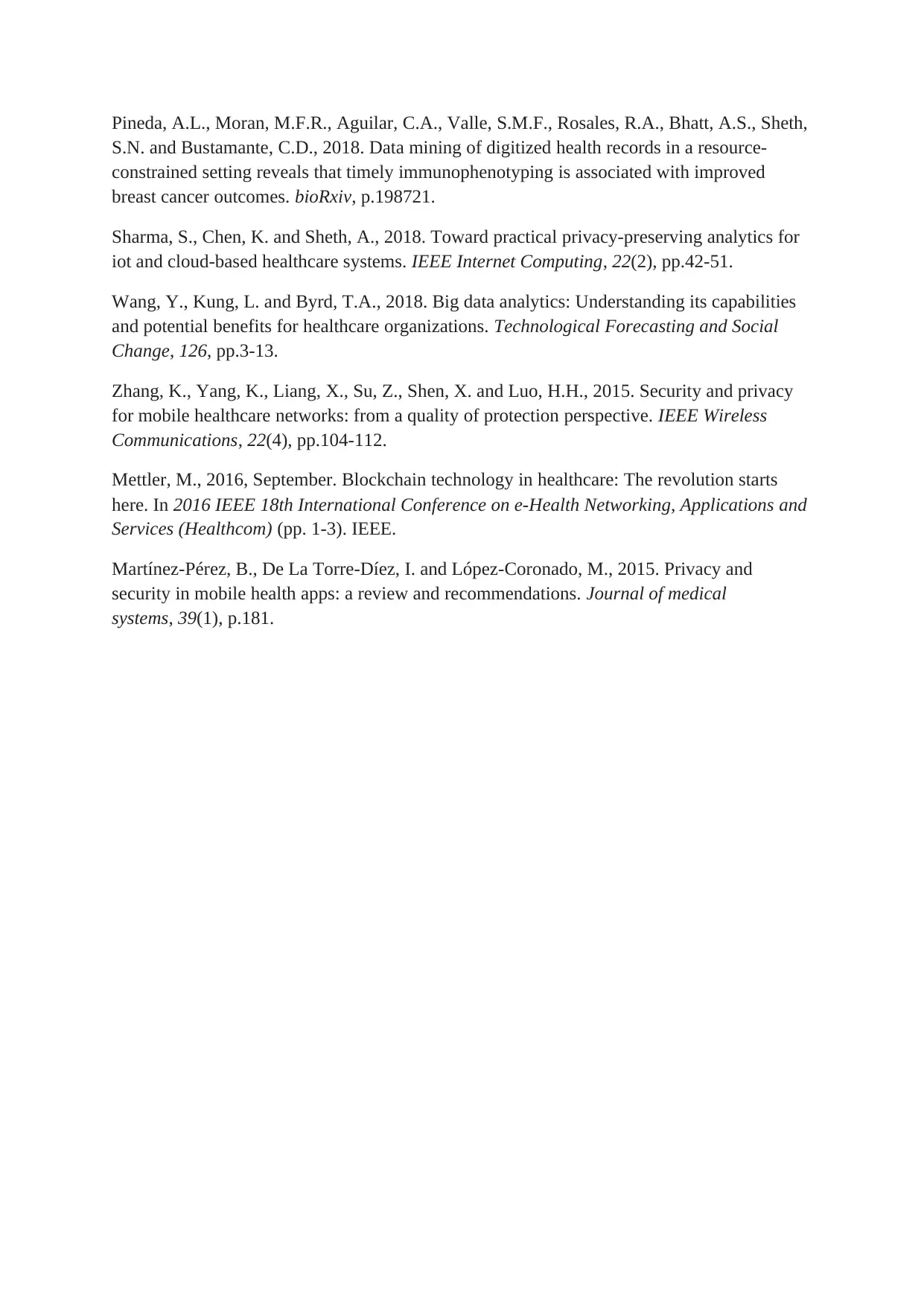
Pineda, A.L., Moran, M.F.R., Aguilar, C.A., Valle, S.M.F., Rosales, R.A., Bhatt, A.S., Sheth,
S.N. and Bustamante, C.D., 2018. Data mining of digitized health records in a resource-
constrained setting reveals that timely immunophenotyping is associated with improved
breast cancer outcomes. bioRxiv, p.198721.
Sharma, S., Chen, K. and Sheth, A., 2018. Toward practical privacy-preserving analytics for
iot and cloud-based healthcare systems. IEEE Internet Computing, 22(2), pp.42-51.
Wang, Y., Kung, L. and Byrd, T.A., 2018. Big data analytics: Understanding its capabilities
and potential benefits for healthcare organizations. Technological Forecasting and Social
Change, 126, pp.3-13.
Zhang, K., Yang, K., Liang, X., Su, Z., Shen, X. and Luo, H.H., 2015. Security and privacy
for mobile healthcare networks: from a quality of protection perspective. IEEE Wireless
Communications, 22(4), pp.104-112.
Mettler, M., 2016, September. Blockchain technology in healthcare: The revolution starts
here. In 2016 IEEE 18th International Conference on e-Health Networking, Applications and
Services (Healthcom) (pp. 1-3). IEEE.
Martínez-Pérez, B., De La Torre-Díez, I. and López-Coronado, M., 2015. Privacy and
security in mobile health apps: a review and recommendations. Journal of medical
systems, 39(1), p.181.
S.N. and Bustamante, C.D., 2018. Data mining of digitized health records in a resource-
constrained setting reveals that timely immunophenotyping is associated with improved
breast cancer outcomes. bioRxiv, p.198721.
Sharma, S., Chen, K. and Sheth, A., 2018. Toward practical privacy-preserving analytics for
iot and cloud-based healthcare systems. IEEE Internet Computing, 22(2), pp.42-51.
Wang, Y., Kung, L. and Byrd, T.A., 2018. Big data analytics: Understanding its capabilities
and potential benefits for healthcare organizations. Technological Forecasting and Social
Change, 126, pp.3-13.
Zhang, K., Yang, K., Liang, X., Su, Z., Shen, X. and Luo, H.H., 2015. Security and privacy
for mobile healthcare networks: from a quality of protection perspective. IEEE Wireless
Communications, 22(4), pp.104-112.
Mettler, M., 2016, September. Blockchain technology in healthcare: The revolution starts
here. In 2016 IEEE 18th International Conference on e-Health Networking, Applications and
Services (Healthcom) (pp. 1-3). IEEE.
Martínez-Pérez, B., De La Torre-Díez, I. and López-Coronado, M., 2015. Privacy and
security in mobile health apps: a review and recommendations. Journal of medical
systems, 39(1), p.181.
1 out of 7
Related Documents
Your All-in-One AI-Powered Toolkit for Academic Success.
+13062052269
info@desklib.com
Available 24*7 on WhatsApp / Email
![[object Object]](/_next/static/media/star-bottom.7253800d.svg)
Unlock your academic potential
Copyright © 2020–2025 A2Z Services. All Rights Reserved. Developed and managed by ZUCOL.





